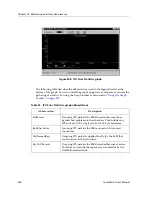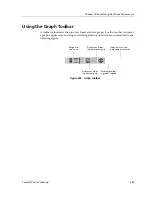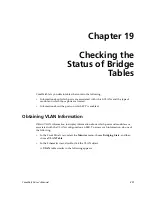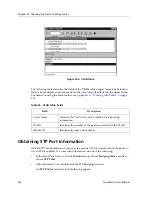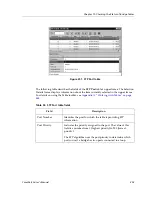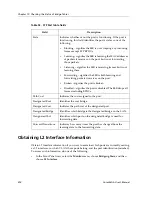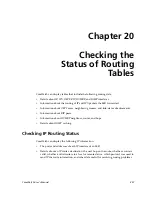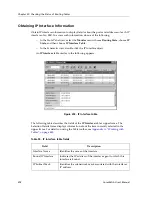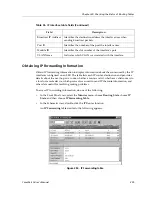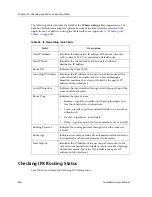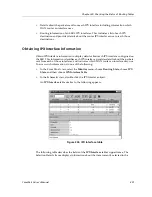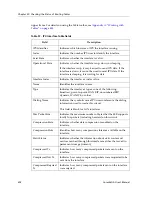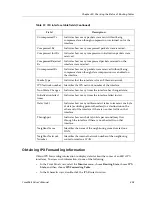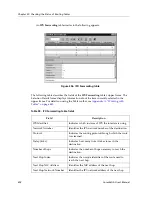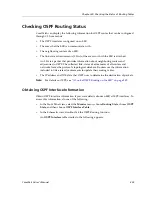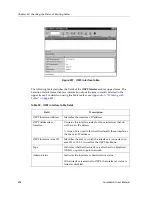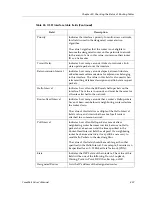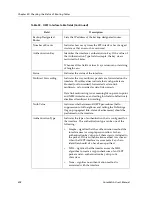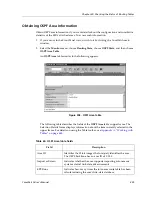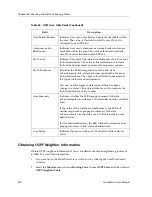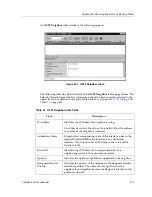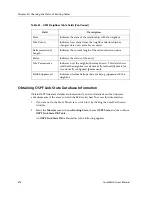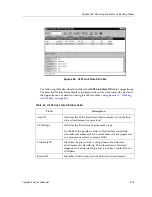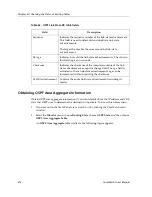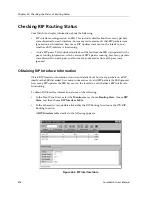
Chapter 20: Checking the Status of Routing Tables
402
CoreWatch User’s Manual
upper frame. For details on using the Table toolbar, see
Appendix A:
“Working with
Tables” on page 443
.
Table 57. IPX Interface table fields
Field
Description
IPX Identifier
Indicates which instance of IPX the interface is using.
Index
Indicates the number IPX uses to identify the interface.
Exist State
Indicates whether the interface is valid.
Operational State
Indicates whether the interface is up, down, or sleeping.
If the interface is up, it may be used to send IPX data. If the
interface is down, it cannot be used to send IPX data. If the
interface is sleeping, it is waiting for data.
Interface Index
Indicates the interface's index value.
Name
Identifies the interface's name.
Type
Indicates the interface's type as one of the following:
broadcast, point-to-point, WAN RIP, unnumbered RIP,
dynamic, WAN WS, or other.
Dialing Name
Indicates the symbolic name IPX uses to reference the dialing
information used to create this circuit.
This field is blank for LAN interfaces.
Max Packet Size
Indicates the maximum number of bytes that the SSR supports
locally for packets (including headers) on this circuit.
Compression State
Indicates whether data compression is enabled on the
interface.
Compression Slots
Identifies how many compression slots area available on the
interface.
Static Status
Indicates whether the information about static routes and
services reached through this interface matches that saved in
permanent storage (current).
Compressed Tx
Indicates how many compressed packets were sent on the
interface.
Compressed Init Tx
Indicates how many compressed packets were requested to be
sent from the interface.
Compressed Rejected
Tx
Indicates how many compressed packets sent on the interface
were rejected.
Summary of Contents for CoreWatch
Page 1: ...CoreWatch User s Manual 9032564 04...
Page 2: ...Notice 2 CoreWatch User s Manual...
Page 20: ...Preface 20 CoreWatch User s Manual...
Page 64: ...Chapter 5 Changing System Settings 64 CoreWatch User s Manual...
Page 86: ...Chapter 6 Configuring SSR Bridging 86 CoreWatch User s Manual...
Page 106: ...Chapter 7 Configuring VLANs on the SSR 106 CoreWatch User s Manual...
Page 206: ...Chapter 12 Configuring QoS on the SSR 206 CoreWatch User s Manual...
Page 246: ...Chapter 13 Configuring Security on the SSR 246 CoreWatch User s Manual...
Page 363: ...CoreWatch User s Manual 363 Chapter 16 Configuring Routing Policies on the SSR 9 Click OK...
Page 364: ...Chapter 16 Configuring Routing Policies on the SSR 364 CoreWatch User s Manual...
Page 370: ...Chapter 17 Checking System Status 370 CoreWatch User s Manual...
Page 390: ...Chapter 18 Monitoring Real Time Performance 390 CoreWatch User s Manual...
Page 396: ...Chapter 19 Checking the Status of Bridge Tables 396 CoreWatch User s Manual...
Page 430: ...Chapter 20 Checking the Status of Routing Tables 430 CoreWatch User s Manual...
Page 442: ...Chapter 22 Obtaining Reports 442 CoreWatch User s Manual...
Page 456: ...Appendix B CoreWatch Menus 456 CoreWatch User s Manual...

